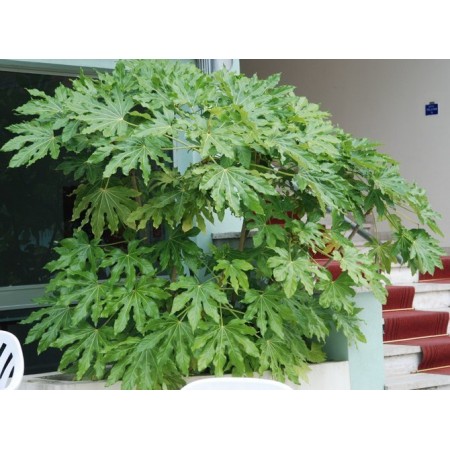Fatsia cultivation

Like any other ivy, Fatsia is very unpretentious in care when grown at home. This is due to the popularity of the plant among modern gardeners who want to grow a decorative garden at home, consisting of lush and beautiful representatives of the flora. However, Fatsia needs a certain approach, and now we will figure out how to properly care for it, so that it delights us with active flowering for several seasons.
Choosing the right place on the premises
The best option for decorative Fatsia would be a place where there is a large amount of scattered solar ultraviolet radiation. Direct rays can leave burns on ivy leaves, so it should be protected from this effect.
As for the fresh air, you will achieve the active flowering of your pet, if in the summer you take it to a non-glazed terrace or balcony. The more air the plant receives, the more saturated will be its color and the greater will be the number of fresh shoots. But in winter it is better to bring Fatsia into the house, as cool or cold will slow down the growth of the flower.
The required amount of watering
It is recommended to moisten the soil in a container with Fatsia stably, but not with too much liquid. The fact is that, like any other plant, Fatsia is very problematic to cope with an excess of moisture. In the pot, it is best to make a drainage layer so that the flower can get rid of excess fluid in a timely manner.
Watering is best suited for water at room temperature, which is pre-settled during the day. The tough fluid coming from the taps of modern apartments and private houses can contain many small particles that adversely affect a living organism. From this, Fatsia can get sick, lose leaves and die quickly.
Humidity and temperature in the room
If you plan to grow fatsia near heating appliances, then get ready for the quick death of the plant. The flower does not take too much air too dry, especially if, at the same time, the number of watering procedures does not increase. The optimal humidity value for it will be an indicator in the region of 60-70%. In case of insufficient air humidification, place water containers near the flowerpot - this ensures that the plant will be stably saturated with liquid in the right quantities.
In summer, the temperature in the room should not exceed 25 degrees. In winter, the flower falls into a stage of slow growth, gaining strength before the next flowering season. At this time, it is best to protect the plant from abundant watering, reducing the amount of fluid introduced to a minimum. In winter, the optimal air temperature for Fatsia will be an indicator within 15-16 degrees of heat. If the temperature is higher, it is sometimes recommended to spray the leaves from the spray gun.